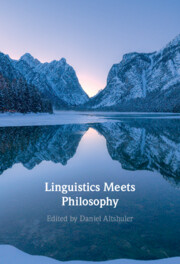Book contents
- Linguistics Meets Philosophy
- Linguistics Meets Philosophy
- Copyright page
- Contents
- Figures
- Tables
- Contributors
- Linguistics Meets Philosophy: A Historical Preface
- Introduction
- Part I Reporting and Ascribing
- Part II Describing and Referring
- Part III Narrating and Structuring
- Part IV Locating and Inferring
- Part V Typologizing and Ontologizing
- Part VI Determining and Questioning
- Part VII Arguing and Rejecting
- Part VIII Implying and (Pre)supposing
- 15 Implicatures
- 16 Presuppositions
- 17 Modals and Conditionals
- Index
- References
17 - Modals and Conditionals
from Part VIII - Implying and (Pre)supposing
Published online by Cambridge University Press: 06 October 2022
- Linguistics Meets Philosophy
- Linguistics Meets Philosophy
- Copyright page
- Contents
- Figures
- Tables
- Contributors
- Linguistics Meets Philosophy: A Historical Preface
- Introduction
- Part I Reporting and Ascribing
- Part II Describing and Referring
- Part III Narrating and Structuring
- Part IV Locating and Inferring
- Part V Typologizing and Ontologizing
- Part VI Determining and Questioning
- Part VII Arguing and Rejecting
- Part VIII Implying and (Pre)supposing
- 15 Implicatures
- 16 Presuppositions
- 17 Modals and Conditionals
- Index
- References
Summary
Modals and conditionals play a starring role in philosophical and linguistic research. The ability to think modally distal thoughts is central to the human capacity to plan and choose; and the ability to express such thoughts is central to the human capacity for collective action. Modals and conditionals have yielded a rich bounty of puzzles about logic, semantics, and pragmatics. I organize this chapter around three topics: the interpretation of epistemic modals, particularly how they interact with their local information; the interpretation of conditionals, with a focus on logical questions; and, finally, practical modality, with discussion of a potentially unified perspective on practical modality as essentially involving reference to actions.
Keywords
- Type
- Chapter
- Information
- Linguistics Meets Philosophy , pp. 502 - 533Publisher: Cambridge University PressPrint publication year: 2022

